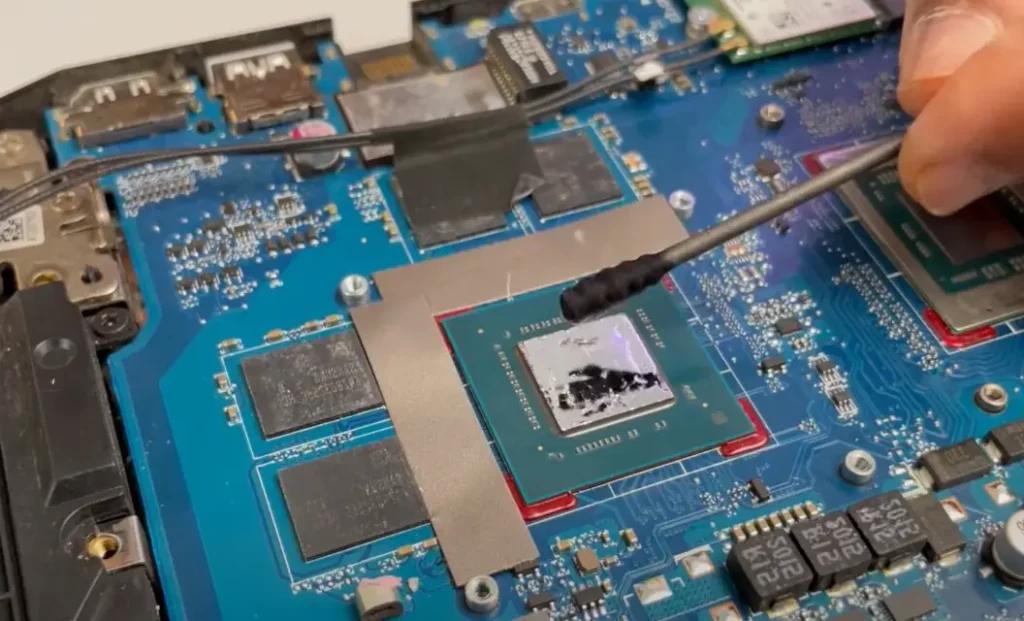Liquid metal vs Thermal paste: Both compounds remove heat from the source to the heat sinks. But besides thermal paste, another thermal interface is a liquid metal, which some consider the future replacement for thermal pastes. Is this so, and what is better for the processor, thermal paste vs. liquid metal?
I’ll examine the differences between liquid metal and thermal paste, exploring their pros and cons and showing how each should be used properly to get the best results possible.
So read on if you’d like expert guidance into which option will be better for efficiently keeping your processing chips cooling needs!
Liquid metal vs Thermal paste
What is liquid metal? – Its composition
Understanding liquid metals is easy; their name tells the story! This material consists of an alloy made from various metal elements, like tin and zinc. It is a type of metal that exists in a thin fluid state. To ensure a liquid form, gallium is added, which melts at 29° C to become a silver puddle.

In most cases, liquid metal is sold in special syringes for thorough application; also, most sets include several spatulas for easy spreading of composition and other materials on the chip surface before work.
What does thermal paste look like, and its composition?

Thermal paste is made of various substances with high thermal conductivity, such as silver, copper, zinc, aluminum oxide, graphite, tungsten, and even ceramics. Each element is mixed in specific proportions to form powdery compounds.
And since the powders are difficult to apply, they are bound together with a special oil for easy application. This lubricant maintains its viscosity over time while providing minimal evaporation.
So, thermal paste looks like a paste and must be carefully placed on the heat-generating component. To ensure proper application, spreading an even layer of thermal paste up to 1mm in thickness is recommended. For convenience, manufacturers often provide spatulas as part of their product packaging, or you can purchase them separately in syringe form.
Liquid metal for the processor: pros and cons
To compare materials, you need to know the advantages and disadvantages. The main advantage of liquid metals is their superior heat conductivity which is higher than thermal paste. Therefore, liquid metal always conducts heat better than paste by at least 5 °C and often even more! Liquid metals thus make it much easier for your CPU functioning good and stay cool during heavy-duty tasks.
Remember – And a critical con of liquid metal material is it can’t be used with aluminum and copper as they can cause corrosion. Avoiding CPU cooler with an aluminum or copper-plated base when purchasing a liquid metal!
Not to mention that liquid metal is expensive compared to thermal paste. Despite being costlier than paste, liquid metal has the same service life.
Applying this substance must be done with caution as it is not simple to remove because metals inherently conduct electricity. A single wrong drop can easily damage the surrounding components of the motherboard VRM. If you are inexperienced, taking a guide might be necessary. The same advice applies to thermal pastes too.
Thermal paste: pros and cons
Among the positive characteristics of thermal paste:
- It is easier to apply than other thermal interfaces.
- Regardless of the composition, it does not conduct current.
- Easier to remove from surfaces.
- It is inexpensive.
While its drawbacks, thermal paste falls short of liquid metal in terms of overheat conduction. Despite this limitation, it has other advantages, making it a viable option for many applications.
Where is the best place to use liquid metal?
For gaming PC enthusiasts, liquid metal is the ideal choice for heat dissipation avoid throttling or crashing PC because of its superior thermal conductivity compared to the traditional thermal paste. You might even notice drop not only in temperature but also in fps of GPU by using liquid metal.
Similarly, those working with graphic and video editors can also benefit from liquid metal, as such activities often cause heavy system loading, requiring enhanced cooling capabilities and overheating protection.
When Thermal Paste Should I Use?
Thermal paste is the ideal choice for most PCs, and it will suit everyone. Thermal paste is an adequate cooling solution if you are not pushing your computer to its total capacity.
When selecting thermal paste for gaming PCs, you must choose one of the excellent grades – preferably high-grade thermal paste – as these more powerful type of processors require a heavier load. Regardless of your PC setup, thermal paste ensures optimal functioning of CPU!
Summary
As I can conclude, liquid metal has a couple of advantages, but the disadvantages interrupt them – in which case, it’s best to opt for thermal paste instead! That way, you won’t experience any unnecessary confusion or complications. All is calm – so use thermal paste if in doubt!
I cannot say that I completely agree with this approach. Liquid metal has been around for a long time, and its pros and cons are known. Its drawbacks can be offset if the application process is slightly modified, as no intricate “magic” is involved – only chemistry and physics.
While Liquid metal is not a simple material, thermal pastes are also not simple for those who lack experience. If you have substantial knowledge about PCs, replacing the thermal interface can be easy regardless of what type of material you’re using. Therefore, it’s crucial to pay attention and know precisely while applying.
If I had to give an opinion, it would be that thermal pastes are more reliable, and their applications are much broader compared to liquid metal. They’re easy to use temperature-wise, practical for nearly any situation, and even better – they don’t require too much effort.
In short, if you do not want or have the time for experimentation on your PC building thing or configuration, go with a tried-and-true option such as thermal paste!
If you want to try new things, are confident in your skills, and ready for any outcome. There is no talk of using liquid metal instead of thermal pastes.
Let me know in the comments if you have any question or something on “Liquid metal vs Thermal paste“.




